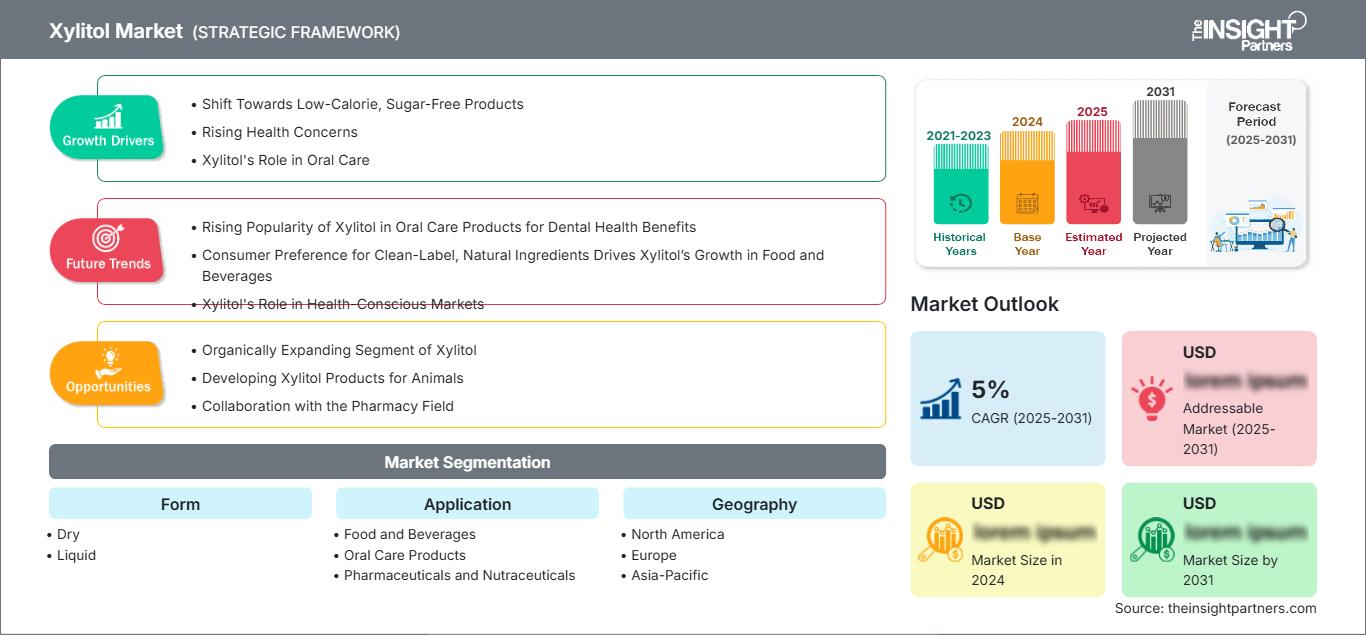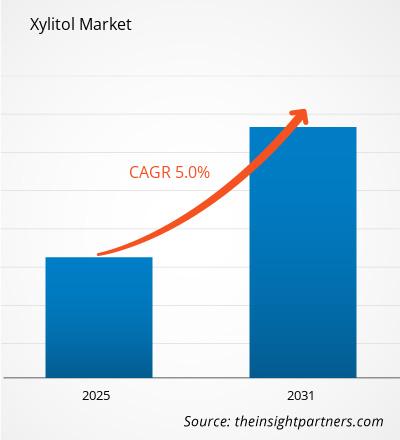Der Xylitol-Markt wird voraussichtlich zwischen 2025 und 2031 eine durchschnittliche jährliche Wachstumsrate (CAGR) von 5 % verzeichnen, wobei die Marktgröße von XX Millionen US-Dollar im Jahr 2024 auf XX Millionen US-Dollar im Jahr 2031 anwachsen wird.
Der Bericht ist nach Form (trocken, flüssig) segmentiert. Der Bericht präsentiert außerdem Analysen basierend auf der Anwendung [Lebensmittel und Getränke (Backwaren und Süßwaren, Milchprodukte und gefrorene Desserts, Getränke, sonstige), Mundpflegeprodukte, Pharmazeutika und Nutraceuticals, Kosmetika und Toilettenartikel]. Die globale Analyse ist weiter auf regionaler Ebene und nach den wichtigsten Ländern aufgeschlüsselt. Geografisch ist der Markt in Nordamerika, Europa, Asien-Pazifik, Naher Osten und Afrika sowie Süd- und Mittelamerika unterteilt. Der Bericht bietet den Wert in USD für die oben genannte Analyse und Segmente.
Zweck des Berichts
Der Bericht „Xylitol Market“ von The Insight Partners zielt darauf ab, die aktuelle Situation und das zukünftige Wachstum sowie die wichtigsten treibenden Faktoren, Herausforderungen und Chancen zu beschreiben. Dies bietet verschiedenen Geschäftspartnern Einblicke, wie beispielsweise:
- Technologieanbieter/-hersteller: Um die sich entwickelnde Marktdynamik zu verstehen und die potenziellen Wachstumschancen zu kennen, damit sie fundierte strategische Entscheidungen treffen können.
- Investoren: Um eine umfassende Trendanalyse hinsichtlich der Marktwachstumsrate, der finanziellen Marktprognosen und der Chancen entlang der Wertschöpfungskette durchzuführen.
- Regulierungsbehörden: Um Richtlinien und Überwachungsaktivitäten auf dem Markt zu regulieren, mit dem Ziel, Missbrauch zu minimieren, das Vertrauen der Investoren zu wahren und die Integrität und Stabilität des Marktes aufrechtzuerhalten.
Xylitol-Marktsegmentierungsformular
- Trocken
- Flüssig
Anwendung
- Lebensmittel und Getränke
- Mundpflegeprodukte
- Pharmazeutika und Nutrazeutika
- Kosmetika und Toilettenartikel
Sie erhalten kostenlos Anpassungen an jedem Bericht, einschließlich Teilen dieses Berichts oder einer Analyse auf Länderebene, eines Excel-Datenpakets sowie tolle Angebote und Rabatte für Start-ups und Universitäten.
Xylitol-Markt: Strategische Einblicke

- Holen Sie sich die wichtigsten Markttrends aus diesem Bericht.Dieses KOSTENLOSE Beispiel umfasst Datenanalysen, die von Markttrends bis hin zu Schätzungen und Prognosen reichen.
Wachstumstreiber für den Xylitol-Markt
- Wechsel zu kalorienarmen, zuckerfreien Produkten: Die Präferenz für kalorienarme, zuckerfreie Ersatzprodukte wächst, was den Xylitol-Konsum in die Höhe treibt. Immer mehr Verbraucher kennen die Vorteile von Xylitol, wie z. B. einen niedrigen glykämischen Index, Vorteile für die Zahngesundheit und seine Vorteile für Diabetiker, was zu einer vermehrten Verwendung in Lebensmitteln, Getränken und Körperpflegeprodukten führt.
- Steigende Gesundheitsbedenken: Da weltweite Probleme wie Fettleibigkeit und Diabetes zunehmen, steigt der Trend zu Zuckerersatzstoffen. Xylitol ist ein natürlicher Süßstoff mit sehr geringem Kaloriengehalt und niedrigem glykämischen Index. Daher ist es für die meisten Hersteller zuckerfreier und kalorienreduzierter Lebensmittelprodukte akzeptabel, was zu mehr und besserem Marktwachstum führt.
- Die Rolle von Xylitol in der Mundpflege: Xylitol ist allgemein dafür bekannt, Karies vorzubeugen und die Mundgesundheit zu verbessern. Da sich die Menschen zunehmend ihrer Mundhygiene bewusster werden, findet Xylitol seinen Weg in Produkte wie Zahnpasta, Kaugummi und Mundwasser. Dies treibt die Nachfrage nach Mundpflegeprodukten an und erweitert deren Markthorizonte.
Zukünftige Trends auf dem Xylitol-Markt
- Steigende Beliebtheit von Xylitol in Mundpflegeprodukten aus zahnmedizinischen Gründen: Die Verwendung von Xylitol in Mundpflegeprodukten wie Zahnpasta, Mundwasser und Kaugummi ist aufgrund seiner zahnmedizinischen Vorteile wie Kariesvorbeugung und Plaquereduzierung zum Trend geworden. Da immer mehr Menschen Wert auf Mundhygiene legen, werden immer mehr Produkte auf Xylitolbasis für die Zahnpflege angeboten.
- Die Vorliebe der Verbraucher für Clean-Label- und natürliche Inhaltsstoffe treibt das Wachstum von Xylitol in Lebensmitteln und Getränken voran: Darüber hinaus bevorzugen die Verbraucher jetzt natürliche und Clean-Label-Produkte und wählen Inhaltsstoffe wie Xylitol anstelle von künstlichen Süßstoffen. Dies zeigt sich in der zunehmenden Verwendung von Xylitol in neu eingeführten Lebensmitteln und Getränken sowie Nahrungsergänzungsmitteln aufgrund der Forderung nach gesünderen und klareren Zutatenlisten.
- Die Rolle von Xylitol in gesundheitsbewussten Märkten: Es hat einen niedrigen glykämischen Index und ist mit einer zuckerfreien Ernährung kompatibel, sodass es sich für die Integration in funktionelle Lebensmittel und Getränke eignet. Immer mehr Produkte wie zuckerfreie Süßigkeiten, Diätgetränke und Proteinriegel verwenden Xylitol als natürlich süßen Zuckerersatz und fördern so sein Wachstum in gesundheitsbewussten Märkten.
Marktchancen für Xylitol
- Biologisch wachsendes Xylitol-Segment: Dieser zunehmende Trend zu Bio- und Clean-Label-Produkten hat sich für Hersteller von Bio-Xylitol als Segen erwiesen. Durch die Einführung von Bio-Xylitol in diesem Segment können die Unternehmen die stetig steigende Nachfrage der Verbraucher nach Lebensmitteln, Getränken und Körperpflegeprodukten mit Bio-Zutaten bedienen und gesundheitsbewussten Käufern ein attraktives Angebot machen.
- Entwicklung von Xylitol-Produkten für Tiere: Xylitol findet zunehmend Verwendung in Tierpflegeprodukten, insbesondere in Form von Zahnpflege-Kauartikeln und Zahnpflege-Leckerlis. Neben den Vorteilen für die Mundgesundheit von Haustieren bietet es dem Bewusstsein der Tierbesitzer auch die Möglichkeit, den Xylitol-Markt für Tierprodukte zu erweitern und so zusätzliche Einnahmen für die Hersteller zu generieren.
- Zusammenarbeit mit der Pharmaindustrie: Der steigende Bedarf an kalorienarmen und nicht-glykämischen Süßstoffen in der Pharmaindustrie bietet hervorragende Chancen für Xylitol. Es sind Kooperationen mit den beteiligten Pharmaunternehmen hinsichtlich der Herstellung von Sirupen, Tabletten oder anderen zuckerfreien oder zuckerarmen Produkten für Diabetiker und Patienten mit anderen Stoffwechselerkrankungen möglich.
Xylitol-Markt
Die Analysten von The Insight Partners haben die regionalen Trends und Faktoren, die den Xylitol-Markt im Prognosezeitraum beeinflussen, ausführlich erläutert. In diesem Abschnitt werden auch die Xylitol-Marktsegmente und die geografische Lage in Nordamerika, Europa, dem asiatisch-pazifischen Raum, dem Nahen Osten und Afrika sowie Süd- und Mittelamerika erörtert.Umfang des Xylitol-Marktberichts
| Berichtsattribut | Einzelheiten |
|---|---|
| Marktgröße in 2024 | US$ XX million |
| Marktgröße nach 2031 | US$ XX Million |
| Globale CAGR (2025 - 2031) | 5% |
| Historische Daten | 2021-2023 |
| Prognosezeitraum | 2025-2031 |
| Abgedeckte Segmente |
By Form
|
| Abgedeckte Regionen und Länder | Nordamerika
|
| Marktführer und wichtige Unternehmensprofile |
|
Dichte der Marktteilnehmer für Xylitol: Verständnis ihrer Auswirkungen auf die Geschäftsdynamik
Der Xylitol-Markt wächst rasant, angetrieben durch die steigende Endverbrauchernachfrage aufgrund von Faktoren wie veränderten Verbraucherpräferenzen, technologischem Fortschritt und einem stärkeren Bewusstsein für die Produktvorteile. Mit steigender Nachfrage erweitern Unternehmen ihr Angebot, entwickeln Innovationen, um den Bedürfnissen der Verbraucher gerecht zu werden, und nutzen neue Trends, was das Marktwachstum weiter ankurbelt.

- Holen Sie sich die Xylitol-Markt Übersicht der wichtigsten Akteure
Wichtige Verkaufsargumente
- Umfassende Abdeckung: Der Bericht analysiert umfassend Produkte, Dienstleistungen, Typen und Endnutzer des Xylitol-Marktes und bietet einen ganzheitlichen Überblick.
- Expertenanalyse: Der Bericht basiert auf dem umfassenden Verständnis von Branchenexperten und Analysten.
- Aktuelle Informationen: Der Bericht gewährleistet Geschäftsrelevanz durch die Berichterstattung über aktuelle Informationen und Datentrends.
- Anpassungsoptionen: Dieser Bericht kann an spezifische Kundenanforderungen angepasst werden und passt sich so optimal an die Geschäftsstrategien an.
Der Forschungsbericht zum Xylitol-Markt kann daher dazu beitragen, die Branchensituation und die Wachstumsaussichten zu entschlüsseln und zu verstehen. Obwohl es einige berechtigte Bedenken geben mag, überwiegen die Vorteile dieses Berichts tendenziell die Nachteile.
- Historische Analyse (2 Jahre), Basisjahr, Prognose (7 Jahre) mit CAGR
- PEST- und SWOT-Analyse
- Marktgröße Wert/Volumen – Global, Regional, Land
- Branchen- und Wettbewerbslandschaft
- Excel-Datensatz
Aktuelle Berichte
Erfahrungsberichte
Grund zum Kauf
- Fundierte Entscheidungsfindung
- Marktdynamik verstehen
- Wettbewerbsanalyse
- Kundeneinblicke
- Marktprognosen
- Risikominimierung
- Strategische Planung
- Investitionsbegründung
- Identifizierung neuer Märkte
- Verbesserung von Marketingstrategien
- Steigerung der Betriebseffizienz
- Anpassung an regulatorische Trends




















 Kostenlose Probe anfordern für - Xylitol-Markt
Kostenlose Probe anfordern für - Xylitol-Markt